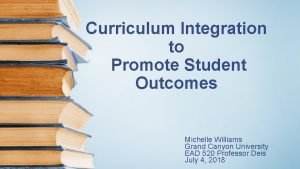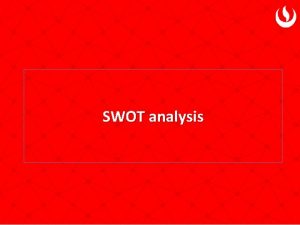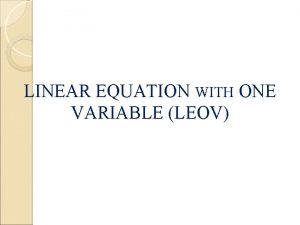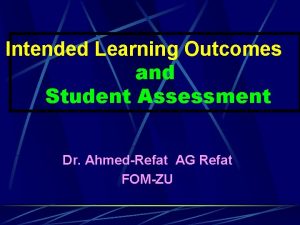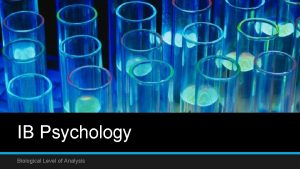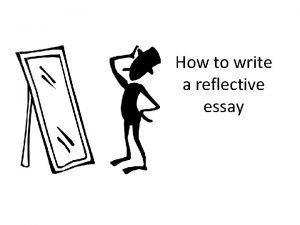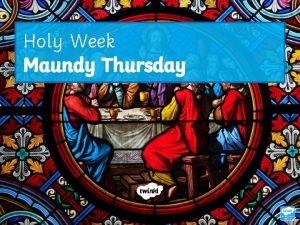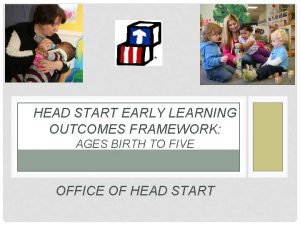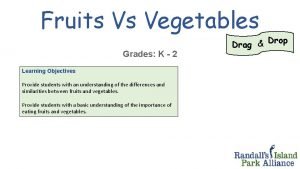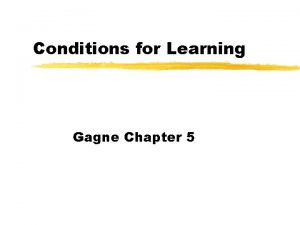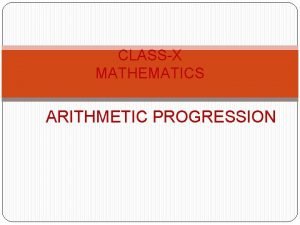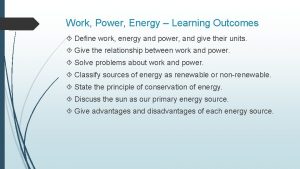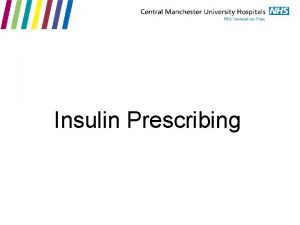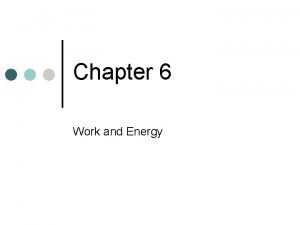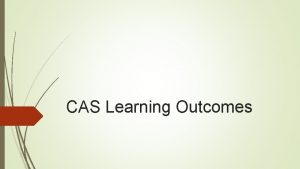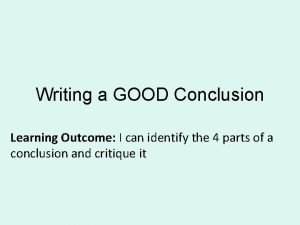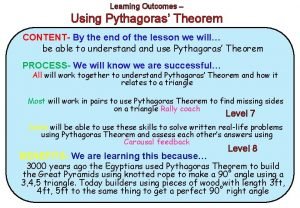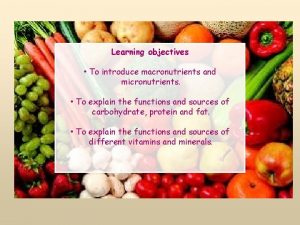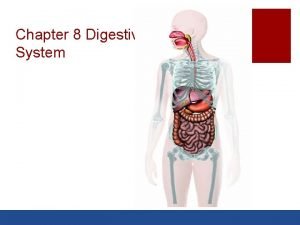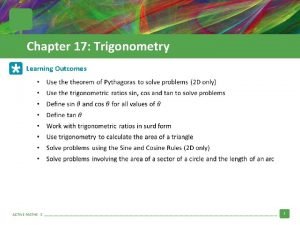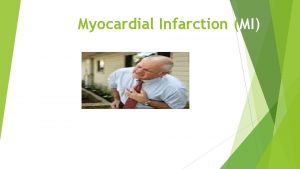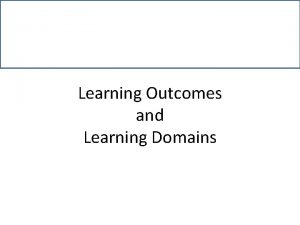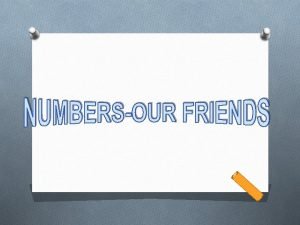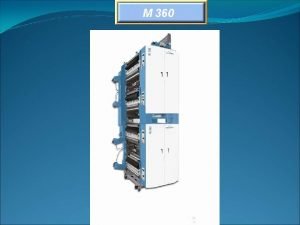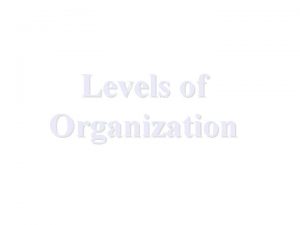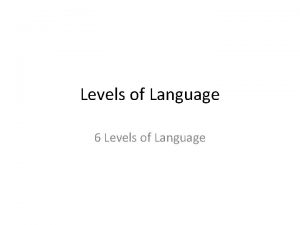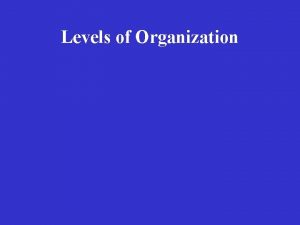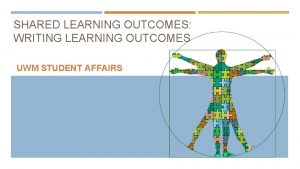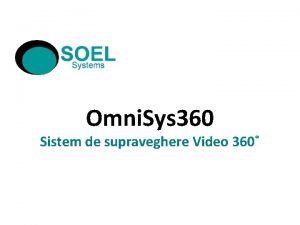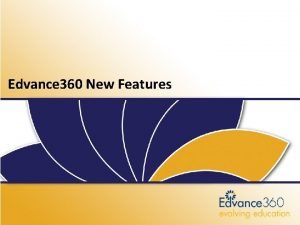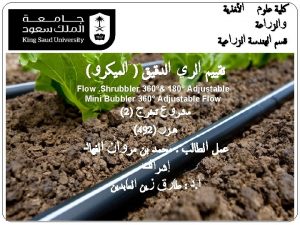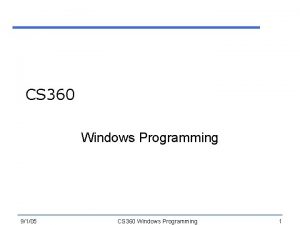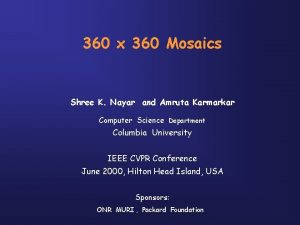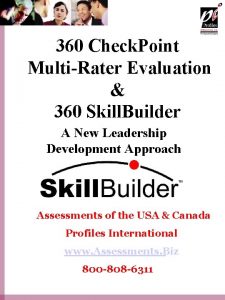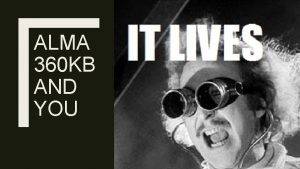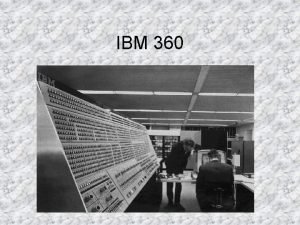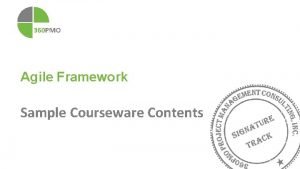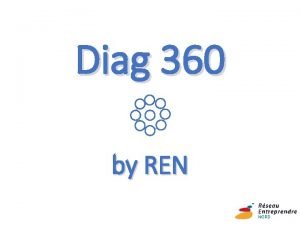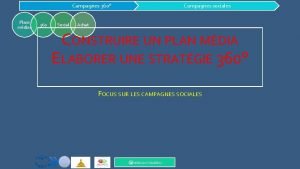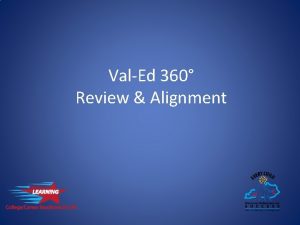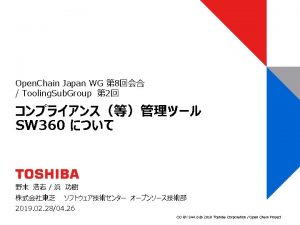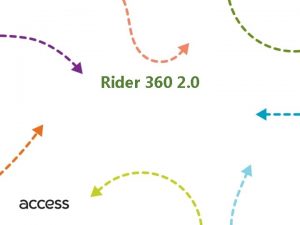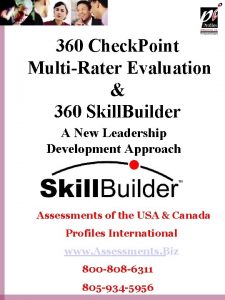360 of Learning Levels of Student Learning Outcomes









































- Slides: 41

360° of Learning Levels of Student Learning Outcomes and How They are Related Lisa Phares Marchand Professor of English as a Second Language Cosumnes River College, Sacramento, CA

General Education and Institutional Outcomes Statements Guide Programs & Influence their Outcomes Statements ILO Assessments Measure Institutional Effectiveness , Inform Governance & Planning, and Influence Resource Allocation PLO Assessments Inform Program Improvement & Resource Allocation Program Learning Course Outcomes Statements Assessments Inform Guide Curriculum PLO Assessment Course Learning Outcomes Statements Guide Content, Materials, and Instruction Course Outcomes Assessments Guide Instructional Improvement Course, Program & GE Outcomes Assessments Inform ILO Assessments Course and Program Outcomes Assessments Inform GELO Assessment

Parameters for Conceiving, Evaluating, or Revising Learning Outcomes

The Concept of Outcomes Mapping We talk about mapping SLO’s in at least three ways. 1. SLO’s at the course level “map” to the instructional materials, methods, and activities that guide students toward achieving the habits of mind, skills, and knowledge that the course SLO’s define. 2. SLO assessments from courses, programs (including “discipline clusters” or “metamajors”), and extracurricular activities “map” to Institutional SLO’s and General Education SLO’s for students earning degrees or transferring. Course and Program SLO measures (should) play a direct role in assessing GELO’s and ILO’s. 3. Institutional Outcomes assessments “map” to, and inform ongoing improvements to, all organizational units, their responsibilities, and their functions.

The Hierarchy of Outcomes: Specific to General Institutional SLO’s Most General: Categories of outcomes for students having attained any specific learning goal at the college Program SLO’s More General: Guide curricular decisions Course SLO’s Most Specific: Data Inform Decision. Making INSTITUTIONAL EFFECTIVENESS Structure course content, methods, and materials Guide and measure student learning across Guide and measure student a range of courses learning RESOUIRCE ALLOCATION

Institutional/College-wide Learning Outcomes • Over-arching categories of outcomes attained by students who have met any specific learning goal at the college • Programmatic: Students can master the learning outcome by following a designated pathway to achieve any of a variety of educational goals. • Measurable: Attainment of the learning outcome can be measured by assessment of one or more SLO’s in courses, programs of study, extracurricular activities, and student service programs. • Comprehensive: Students who successfully complete an educational goal will have achieved an appropriate set of learning outcomes that affirm ability to: • Use reasoning skills and critical habits of mind to collect and analyze information in order to solve problems. • Communicate effectively in a variety of modes. • Employ technology. • Participate in society as a culturally competent and socially responsible community member who promotes sustainability.

“Program Learning Outcomes” …the concept may need some refinement. “Program” = degree certificate courses services activities OTHER

Organizational Units have “Program Learning Outcomes” …but they aren’t all alike… PROGRAMS Instructional Programs Curricular Programs The GE Program Extra. Special Curricular Programs Non-Instructional Programs PATHWAY Administrative Student Support Programs

The GE Program

The General Education Program: Language and Rationality Courses Humanities Courses Social & Behavioral Science Courses Natural Science Courses Living Skills Courses

General Education Outcomes • Accommodate Articulation with Transfer Institutions • Comprehensive: General Education Program Outcomes delineate students’ ability upon completing any course of study for a degree or transfer. Students transferring or earning degrees have met learning outcomes across a range of disciplines including: • Languages and Rationality • • • with competencies in English composition, Communication, Analytical Thinking, and Mathematics Humanities Living Skills Natural Science Social and Behavioral Science • including American Institutions and Ethnic/Multicultural Studies • Curricular: Guide decisions about courses and their requirements within and across programs, majors, and discipline clusters. • Measurable: On-going assessment informs revisions to improve educational opportunities in order to afford students a learning experience with goals and rigor parallel to those provided by any state college or university.

PROGRAM = An Extra-Curricular Program: Comprised of a set of roles filled by Out-of-Class Instructional Personnel Direct Interaction with individual students Coordination with colleagues in Curricular Programs Non-curricular workshops/ teaching events Responsibility for materials to support curricular programs Further contribute to institutional learning outcomes

PROGRAM = Non-Curricular Program: Comprised of the Duties and Functions of Out-of-Class Personnel Job Description Job Description

No matter how the program outcomes are described, outcomes need to be assessed. Right?

Outcomes Assessment: Assessment Data Analysis/Dialogue Improvement

Co Studen Develo t pment PLOs Lib rar y PL Os h alt Os He es PL vic Ser un PLOseling s id A ial c n Os a n Fi PL ng Tutori PLOs

Assessment Data Analysis/Dialogue Assessment Improvement Data Analysis/Dialogue Improvement Assessment Data Analysis/Dialogue Improvement

So … how is all this supposed to make SLO work more meaningful?

Instructional Program Outcomes • Curricular: Guide decisions about courses and requirements for program completion. • Measurable: On-going assessment informs revisions to improve programmatic efficacy. • Comprehensive: Program Student Learning Outcomes delineate abilities of successful completers to: • Communicate a complex understanding of content matter of the discipline. • Demonstrate competence in the habits of mind and technical skills essential to entry into higher levels of study from the discipline. • Use a range of reliable resources to gather appropriate information. • Apply the modes of analysis of the discipline (or metamajors) to solve significant problems. • Exhibit characteristics of ethical decision making based on cultural competence and personal responsibility for social justice and sustainability. • Accommodate Articulation with Transfer Institutions

COURSE CONTENT PROGRAM OUTCOMES instructi on Student Learning Outcome

Program outcomes guide decisions about which courses to offer & specify what the courses must enable students to learn. Students in a program need facilities and support services to support their learning.

PROGRAM OUTCOMES COURSE CONTENT Out-of-Class Support & Human Resources for Student Learning Needed Facilities, Technology, & Materials

PROGRAM = A Curricular Program Out-of-Class Support and Resources GE Courses Facilities to Support Learning in the Program Majors Courses Other

PROGRAM OUTCOMES STUDENT LEARNING OUTCOMES Out-of-Class Support & Human Resources for Student Learning Needed Facilities, Technology, & Materials Learning

Outcomes in Guided Pathways

Student Learning Outcomes Administrative & Institutional Infrastructure Outcomes

STUDENT SUPPORT PROGRAMS OUTREACH ASSESSMENT Bridge FYE ARTICULATION TRANSFER WORK PLACE LIAISON Curricular Program Out-of-Class Support and Resources GE Courses Facilities to Support Learning in the Program Majors Courses Other INSTRUCTIONAL SUPPORT PROGRAMS – INSTRUCTIONAL TECHNOLOGY ADMINISTRATIVE PROGRAMS & CLASSIFIED SERVICES


What happens to students in their classes?

Course SLO’s • Curricular: They inform decisions about course content, materials, and instructional activities. • Learner Centric: SLO language is accessible to students and guides their learning in the course. • Measurable: Regular assessment of course SLO attainment guides decisions about how the course is taught, and allows immediate intervention when students fall behind. • Inform Program Learning Outcomes: Achieving course level SLO’s contributes significantly to achieving PLO’s. • Some courses stand to support General Education Learning Outcomes (GELO’s) as well as one or more PLO’s.

Current SLO Assessment Paradigm Student Learning Behaviors & Grading SLO Assessment & Reporting

5 courses x 150 students = 3, 000 papers + meetings & SLO Assessments & Program Review Ya gotta be frikin’ kiddin’ me!

SLO-Centric Instruction is the guided pathway inside the classroom.

In SLO-Centric Instruction, Student Learning Outcomes are “unpacked” to determine • course content and lesson design • materials and methodology selection • channels for giving students feedback on their progress • grading schemes that align course grades to outcomes achievement • embedded outcomes assessment

COURSE CONTENT LEARNING SOURCES LEARNING PROCESS LEARNING OUTCOMES SUCCESS-DATA Course Objectives Learning Targets Student Learning Outcomes Assessment • Are derived from • The knowledge, intended SLOs skills and habits of • define course mind students know content. they are trying to • guide the teacher in master selecting methods, materials, and Lessons activities to facilitate students’ acquisition • Lecture of course content. • Text • Activities Exit Skills • Homework Mental and actual • Research tools successful • Experimentation students will be able • Practice to apply • Explicit metacognitive skills instruction • Know the learning targets • Statements that • Engage in lessons describe what with attention to the successful students learning targets can do at the end of • Get feedback on the course. progress through • Several Objectives quizzes and tests and their component • Seek to improve learning targets are • Practice higher order integrated to meet skills such as an outcome. analysis, integration, • Students’ products and evaluation evidence acquisition • Demonstrate ability of course content in to apply learning measurable forms. • Evaluation of student success • Interpreted to identify patterns of strengths and challenges in teaching and learning • Applied to improve course, methods, materials, and/or learning activities • Integrated with other course-level data to inform Program Review

The Teacher The Classroom The Student Learning Targets Activities Competency Feedback • Achieve Learning Targets • Develop Exit Skills • Demonstrate SLOs From Course SLOs Develop • • Course Content Course Objectives Materials Methods

COURSE CONTENT objective Learning Target Learning Target Exit Skills objective Learning Target Exit Skills PROGRAM OUTCOMES objective Exit Skills Learning Target Student Learning Outcome

SLO Assessments Evidence Based Instructional Design Evidence Based Resource Allocation Relevant Support & Learning Environment



 Ncbts learning outcomes
Ncbts learning outcomes Four career stages of ppst
Four career stages of ppst Ead 520
Ead 520 Student learning soace
Student learning soace 3 levels of thinking
3 levels of thinking Learning outcome example
Learning outcome example Water cycle learning outcomes
Water cycle learning outcomes Give a lesson plan for notice writing
Give a lesson plan for notice writing What is the objective of swot analysis
What is the objective of swot analysis Rhymes with understand
Rhymes with understand Example of learning objectives
Example of learning objectives Photolysis of water
Photolysis of water Learning objectives of photosynthesis
Learning objectives of photosynthesis Learning outcomes of linear equations in one variable
Learning outcomes of linear equations in one variable Learning outcome generator
Learning outcome generator Reported speech objectives
Reported speech objectives Purpose of learning outcomes
Purpose of learning outcomes Objectives of input output management
Objectives of input output management Ib psychology learning outcomes
Ib psychology learning outcomes How to write an introduction for a reflective essay
How to write an introduction for a reflective essay Learning outcomes of holy week
Learning outcomes of holy week Holy week learning outcomes
Holy week learning outcomes Headstart early learning outcomes framework
Headstart early learning outcomes framework Learning objectives of fruits and vegetables
Learning objectives of fruits and vegetables Gagne's five categories of learning
Gagne's five categories of learning Sum of arithmetic progression
Sum of arithmetic progression A gift of chappals lesson plan for teachers
A gift of chappals lesson plan for teachers Sound energy definition
Sound energy definition Sales and revenue are the same
Sales and revenue are the same Cooking learning outcomes
Cooking learning outcomes Humalog sliding scale
Humalog sliding scale Learning objectives of work and energy
Learning objectives of work and energy Cas learning outcomes
Cas learning outcomes Conclusion of learning outcomes
Conclusion of learning outcomes State and prove pythagoras theorem
State and prove pythagoras theorem Learning about macronutrients
Learning about macronutrients Chapter 8 digestive system
Chapter 8 digestive system Learning outcome
Learning outcome Angina pectoris pathophysiology
Angina pectoris pathophysiology Hot seating questions examples
Hot seating questions examples Mqf 8 domains
Mqf 8 domains Hindu writing
Hindu writing


